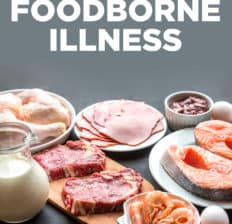This Dr. Axe content is medically reviewed or fact checked to ensure factually accurate information.
With strict editorial sourcing guidelines, we only link to academic research institutions, reputable media sites and, when research is available, medically peer-reviewed studies. Note that the numbers in parentheses (1, 2, etc.) are clickable links to these studies.
The information in our articles is NOT intended to replace a one-on-one relationship with a qualified health care professional and is not intended as medical advice.
This article is based on scientific evidence, written by experts and fact checked by our trained editorial staff. Note that the numbers in parentheses (1, 2, etc.) are clickable links to medically peer-reviewed studies.
Our team includes licensed nutritionists and dietitians, certified health education specialists, as well as certified strength and conditioning specialists, personal trainers and corrective exercise specialists. Our team aims to be not only thorough with its research, but also objective and unbiased.
The information in our articles is NOT intended to replace a one-on-one relationship with a qualified health care professional and is not intended as medical advice.
Foodborne Illness Symptoms, Causes + How to Treat and Prevent One
May 8, 2022

In the United States, the Centers for Disease Control and Prevention (CDC) estimates that there are about 48 million cases of foodborne illness every year.
Bacteria such as E.coli, salmonella and campylobacter are responsible for many public foodborne outbreaks. These pathogens can cause a range of symptoms once they enter someone’s body, including diarrhea and vomiting.
What can you do to protect yourself? Generally speaking, follow these four steps to prevent yourself from consuming contaminated foods: “clean, separate, cook, and chill.”
Let’s look below at specific foods that should be eaten with caution, plus other ways to prevent food poisoning.
What Is a Foodborne Illness?
A foodborne illness occurs when someone eats or drinks foods or beverages that have been contaminated with pathogens. This causes a negative reaction in the gut, triggering the immune system to respond.
There are many different types of microbes – meaning bacteria, viruses and parasites – that can cause foodborne illnesses. Symptoms differ depending on the type that someone consumed, with certain types more severe and dangerous than others.
Is a foodborne illness illnesses the same thing as food poisoning?
These terms are mostly used interchangeably, although some experts consider the two to have a slight difference.
Food poisoning is basically a type of foodborne illness that usually causes symptoms to start quickly, within about several hours of eating something contaminated. When someone has food poisoning, that person usually has pretty severe symptoms, including vomiting and loss of appetite. The symptoms are caused by consumption of toxins/poison that are created by microorganisms in food.
Types/Varieties
How many different types of foodborne illnesses are there? There are many types considering that numerous bacteria and viruses — at least 250 known varieties — can make someone sick.
What are the five major types of foodborne illnesses?
In the U.S., the types of pathogens that get the most attention for causing food poisoning include: Escherichia coli (also called E. coli), Listeriosis/Listeria monocytogenes (also called listeria) and Salmonellosis (also called salmonella).
These are all harmful bacteria sometimes found in foods such as raw eggs, raw milk or cheeses, unwashed raw vegetables, and foods that sit out at room temperature at places like buffets.
Norovirus is also a common virus that causes food poisoning symptoms.
The CDC has found that these pathogens are responsible for most foodborne illnesses in the United States most years:
- Campylobacter (Campylobacteriosis)
- Salmonellosis (salmonella)
- Shigellosis (Shigella)
- Escherichia coli (E. coli)
Other viruses and bacteria found in contaminated foods that can cause negative reactions include:
- Staphylococcus aureus (Staph)
- Clostridium perfringens
- Norovirus infection (aka Norwalk virus, calicivirus, viral gastroenteritis)
- Giardiasis (Giardia)
- Yersiniosis (Yersinia species)
- Cryptosporidiosis (Cryptosporidium)
- Cyclosporiasis (Cyclospora spp.)
- Toxoplasmosis (Toxoplasma gondii)
- Vibrio infection (Vibrio parahaemolyticus)
- Scombroid fish poisoning
- Hepatitis A
Aside from microbes causing foodborne illnesses, chemicals such as metals and other toxins found in contaminated foods can also cause people to become sick.
Symptoms
After exposure to a pathogen, someone is likely to develop symptoms within several days and sometimes as quickly as within one to two hours.
The most common foodborne illness symptoms include:
- Diarrhea
- Vomiting
- Abdominal cramps
- Nausea and loss of appetite
- Fever
- Headache
- Joint and muscle aches and pains
- Fatigue and weakness
How long do foodborne illness symptoms usually last? Most people experience symptoms for about two to three days, but they might only occur for about one day or for as long as 10 days.
Causes
Most foodborne illnesses are caused by someone eating contaminated food or drinking contaminated water.
Other causes can include exposure to a sick animal or, in some cases, the spread of pathogens from person to person. For example, if someone is sick with diarrhea or is vomiting due to an illness and doesn’t carefully wash his or her hands, that person is capable of spreading germs that can make someone else sick.
Foods/beverages that pose the greatest risk for causing foodborne illnesses include:
- Raw/undercooked animal products, such as raw meat, poultry or eggs
- Unpasteurized milk (aka raw milk) and soft, unpasteurized cheese
- Raw shellfish
- Raw sprouts, which can hold on to bacteria
- Deli meats/cold cuts that aren’t properly stored
- Fruits and vegetables grown near animal waste/manure, which is sometimes used as fertilizer
- Produce that is washed with contaminated water (this can include imported berries, lettuces and herbs such as basil)
- Unpasteurized fruit juices or cider, which can be home to bacteria that forms
- Homemade fermented foods that are made with unclean equipment
- Foods canned at home that aren’t sealed properly
- Cooked foods that are not reheated after contact with an infected food handler
- Unrefrigerated or improperly refrigerated pre-made foods, like meats, potato and egg salads, cream pastries, etc.
Cooking/heating foods can help kill many pathogens, so generally speaking, raw foods or those that have been sitting at room temperature for long periods tend to contain the most bacteria/microbes. This means that raw/spoiling foods are most likely to make people sick.
Another risk factor for experiencing food poisoning is traveling, especially internationally and in remote places where the water may be contaminated. This can cause people to develop enteric fever infections, which are usually associated with consumption of sewage-contaminated water.
How to Treat and Prevent
1. Cook High-Risk Foods and Avoid Eating Raw Animal Products
Cooking foods thoroughly is one of the best ways to destroy bacteria that can make you sick.
It’s especially important to cook meat, poultry, shellfish and eggs, which pose the greatest risk for transferring harmful microbes.
Cook specific foods to a heating point at which the bacteria they’re more likely to be contaminated with will die. This includes:
- 145 degrees Fahreneit for whole cuts of beef, pork, etc.
- 160 F for ground meats.
- 165 F for all poultry.
- 165 F for leftovers.
- 145 F for fish.
If you consume raw foods, such as sushi or beef tartar, make sure they’re very high-quality, fresh, stored at cool temps and kept away from other foods.
It’s recommended that you avoid eating these types of raw foods altogether if you’re at high risk for experiencing severe food poisoning symptoms — for example, if you’re pregnant or immunocompromised.
2. Use Caution When Consuming Raw Dairy
While raw milk and foods made from raw milk, such as yogurt or kefir, do contain many beneficial nutrients, they can potentially expose you to bacteria that can make you ill.
The same can be said for raw/unpasteurized milk as well as raw meat and fish. Know where your food comes from, make sure it’s very fresh and stored properly, and use caution if you’re susceptible to becoming sick easily.
3. Practice Safe Food Handling and Good Hygiene
When cooking meat or fish at home, always use good hand washing, and thoroughly clean all kitchen equipment (juicers, blenders, knives, cutting boards, utensils, etc.). The best way to clean kitchen equipment is in the dishwasher since the high heat kills bacteria.
Keep meat and other animal products away from other foods by storing them in sealed containers inside the refrigerator at 40 degrees Fahrenheit or colder.
4. Stay Hydrated If You Become Sick
If you do develop food poisoning symptoms, eat a bland diet, and stay hydrated by drinking lots of water or fluids like coconut water, herbal tea (like ginger or peppermint) or bone broth.
Eat smaller meals to avoid aggravating your stomach, and stay away from very fatty meals or spicy and acidic foods along with alcohol. Ginger products and peppermint oil may help reduce nausea.
Make sure to wash your hands throughout the day, especially after using the bathroom or vomiting, to avoid spreading any germs.
5. Talk to Your Doctor Before Traveling Internationally
If you’re planning to travel somewhere where contaminated foods and water are a potential issue, ask your doctor how you can protect yourself.
Consider avoiding certain foods while there, as well as public drinking water, and potentially protecting yourself against typhoid fever if you are traveling to an area of the world where typhoid fever is more common, such as parts of Asia and the Middle East.
Risks and Side Effects
In the U.S., foodborne illnesses lead to an estimated 128,000 hospitalizations and 3,000 deaths each year (more or less depending on the year).
Some populations are at greater risk for experiencing severe symptoms, such as pregnant women, young children, older people and those with weakened immune systems. This is why it’s imperative for these groups to seek attention from a health care provider if they become sick with a foodborne illness.
Rarely, some types of foodborne illnesses, such as listeriosis (from listeria), can lead to serious complications. For example, listeria is capable of invading the blood or brain and causing meningitis, an infection around the brain. It can also possibly contribute to miscarriage, stillbirth, preterm labor, and severe illness or death in pregnant women and fetuses.
If you experience food poisoning symptoms that don’t go away within several days, especially if you’re very dehydrated, have a high fever and/or are at risk for complications, visit your health care provider for help. Let your doctor know of symptoms such as excessive nausea and vomiting, bloody diarrhea, or high fever.
Conclusion
- What are foodborne illnesses? They are reactions caused by pathogens (such as virus, bacteria or parasites) in contaminated foods or drinks.
- What are the most common foodborne illnesses? In the U.S., they include those caused by E.coli, salmonella, norovirus, Clostridium perfringens, Campylobacter and Staphylococcus aureus, aka staph.
- Foodborne illness symptoms tend to include diarrhea, vomiting, fatigue, abdominal pains, weakness and sometimes a fever. If they last more than several days, it’s important to get help, especially for pregnant women, the elderly, young children and those who are immunocompromised.




